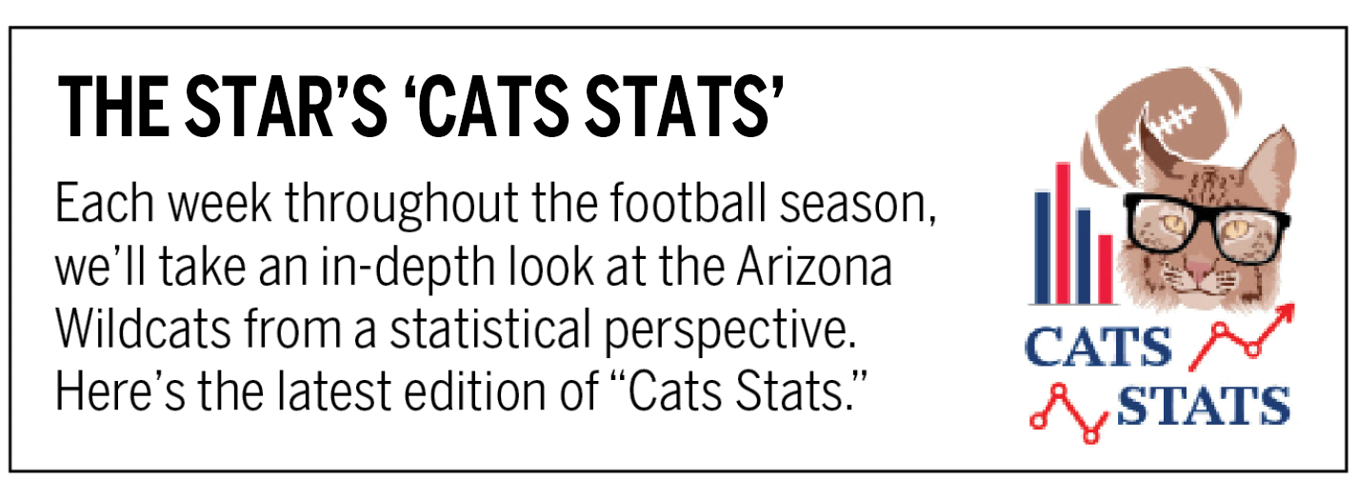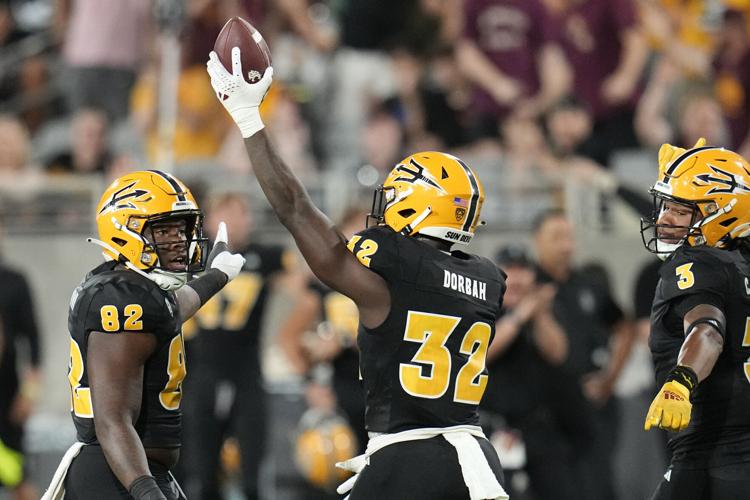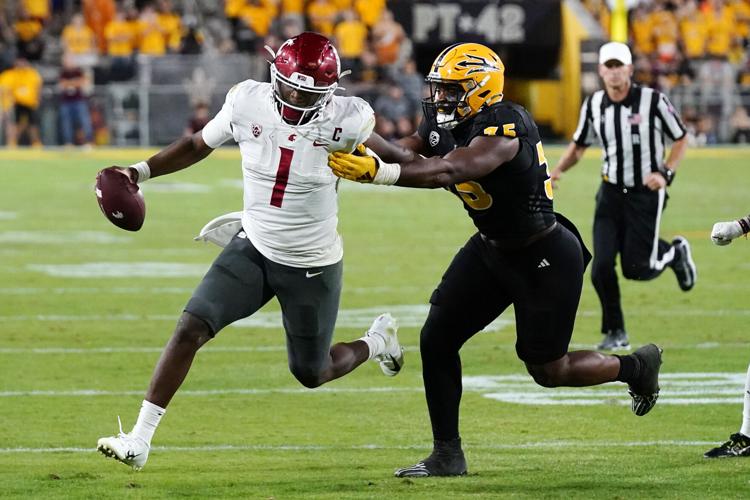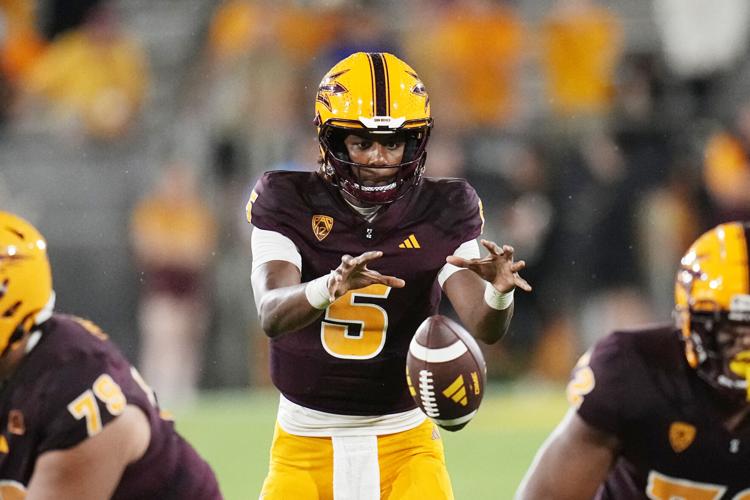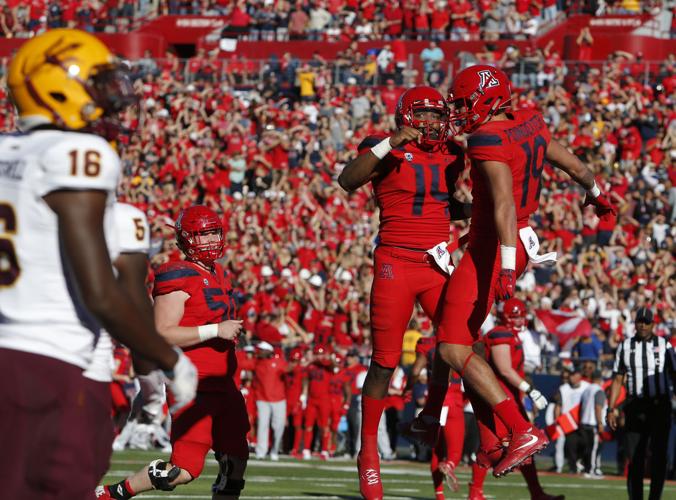On paper, the 2023 Territorial Cup is a mismatch. Arizona should defeat Arizona State handily.
But as we all know, rivalry games don’t always go that way.
Before last year, the last time the Wildcats defeated the Sun Devils was 2016. Arizona entered that game 2-9 with an eight-game losing streak; ASU was 5-6 and in need of one more win for bowl eligibility. The Sun Devils were slight favorites. They lost 56-35.

Like the 2016 Wildcats, this ASU team has been decimated by injuries, especially on offense. The Sun Devils have had some truly horrific performances. But they’ve also been a tough out in unexpected spots.
ASU gave still-unbeaten Washington a major scare in Seattle. The Sun Devils stunned UCLA at the Rose Bowl as 14.5-point underdogs.
The games before and after that upset win? Woof.
With injuries sacking the QB room, ASU lost 55-3 at Utah. The Utes outgained the Sun Devils 513-83.
Last week, ASU lost 49-13 against Oregon — and it really wasn’t that close. The Ducks led 42-0 at halftime. Oregon had 444 yards of offense at the break.
Which version of the Sun Devils will show up Saturday?
In this week’s “Cats Stats,” we’ll look at ASU through a numerical lens. The truth about the Devils lies in these details.
What ASU does well
Despite those barely competitive performances against Utah and Oregon, ASU has pieced together a decent defense.

Arizona State defensive lineman Prince Dorbah (32) celebrates a defensive stop against Washington State with linebacker Travion Brown (82) and defensive lineman Clayton Smith (3) during the second half of their game on Oct. 28.
The Sun Devils rank sixth in the Pac-12 in total defense (376.6 ypg), one spot behind the Wildcats (344.1). ASU is seventh in yards allowed per play, yielding a respectable 5.64.
ASU holds the exact same positions in run defense — sixth in yards allowed per game (137.3) and seventh in yards allowed per rush (4.24).
The Sun Devils are especially stingy on third downs and in the red zone.
ASU has held opponents to a third-down conversion rate of 38.7%, which ranks fifth in the Pac-12. Arizona has risen to second in offensive conversion rate (47.8%) after going 7 for 11 against Utah’s elite third-down stop unit.
The Sun Devils have yielded a red-zone touchdown rate of 51.1% — second best in the conference behind UCLA (36.7%). Arizona has made a steady climb in red-zone offense under Jedd Fisch, going from 30.8% to 59.3% to 68.1% in TD rate over the past three seasons.
Red-zone results can swing a game. ASU’s fourth-quarter comeback in the 2018 Territorial Cup likely wouldn’t have been possible if Arizona had converted more of its red-zone opportunities. The Wildcats settled for field goals of 36 or fewer yards three times in the first half. They also kicked a 40-yarder in the third quarter after a drive that started at the ASU 25 following J.J. Taylor’s 66-yard kickoff return.
Speaking of kickoff returns, ASU boasts the top returner in the Pac-12 in Elijhah Badger (28.9). Tyler Loop typically eliminates the return game by booting the ball into the end zone (89.4% touchback rate, second nationally). But the Wildcats better pay attention to where the Sun Devils’ returners line up; a 100-yard return from deep in the end zone launched the 70-7 nightmare of 2020.
Badger is easily ASU’s most prolific receiver. His 65 catches rank seventh in the Pac-12, although his three touchdowns are tied for the lowest among the top 20. Versatile Cameron Skattebo has accounted for 10 touchdowns in three different ways: rushing (eight), receiving (one) and passing (one).
ASU’s most dangerous weapon, by far, is defensive end B.J. Green II. Green ranks third in the Pac-12 with 53 quarterback pressures, according to Pro Football Focus. Only future pros Laiatu Latu of UCLA (62) and Bralen Trice of Washington (58) are ahead of him.

Washington State quarterback Cameron Ward, left, gets stopped by Arizona State defensive lineman B.J. Green II during the second half of their game Saturday on Oct. 28 in Tempe.
One final note here: The Sun Devils generally haven’t hurt themselves with penalties under Kenny Dillingham, averaging 5.9 infractions per game (fourth fewest in the Pac-12). ASU was the most penalized team in the league last year (7.3).
Where the Sun Devils struggle
ASU ranks in the bottom quarter of the Pac-12 in multiple categories. Most reflect the Sun Devils’ offensive ineptitude, which is largely a product of injuries at quarterback and along the offensive line.
ASU ranks last or next to last in the Pac-12 in total offense (323.7 ypg), yards per play (4.75), scoring (17.3 ppg), completion rate (55.9%), yards per pass attempt (5.9), touchdown passes (seven), interceptions thrown (12), turnovers gained (eight) and turnover margin (minus-9). The Sun Devils are 10th in rushing (101.7 ypg) and ninth in average per rush (3.37). Unless you’re Iowa, it’s really hard to win that way.
ASU is the only team in the Pac-12 with fewer than 10 touchdown passes. Former Marana High School standout Trenton Bourguet, who has fought through injuries all season, has just one TD pass in 248 attempts. He had three in 48 attempts in last year’s Territorial Cup.

Arizona State quarterback Jaden Rashada takes a snap during the second half of the Sun Devils' game against Southern Utah Friday, Sept. 1, 2023, in Tempe. Arizona State won 24-21.
The Sun Devils’ leader in passing touchdowns, freshman Jaden Rashada, could return to action Saturday; he’s been out since Week 2. Rashada began the season as ASU’s starter and threw three TD passes in his first two college games — a promising start in a tiny sample size.
Five Sun Devils have thrown at least one interception — surpassing the 2021 Wildcats’ four. It’s safe to say that turnovers have played a critical role in recent Territorial Cups.
ASU outgained Arizona 537-480 in last year’s 38-35 UA victory. But the Wildcats were plus-4 in turnover margin and ended the Sun Devils’ final two drives with takeaways.
The previous year, Arizona hung around and had the ball at the ASU 22-yard line down 31-15 in the fourth quarter. Will Plummer then threw a pick-six that effectively ended the game.

Arizona quarterback Khalil Tate (14) and receiver Shawn Poindexter (19) celebrate in the first half of the Wildcats' game against Arizona State, Saturday, Nov. 24, 2018, at Arizona Stadium.
Arizona turned the ball over seven times during the 70-7 fiasco. Khalil Tate threw a career-high three interceptions in the Wildcats’ 24-14 loss in 2019. Turnovers by Tate and Taylor fueled ASU’s rally in ’18. A blocked punt (which technically isn’t a turnover but has the same effect) and an interception sparked the Sun Devils’ second-half surge in the ’17 matchup.
The easiest path for up-and-down ASU to make the ’23 Territorial Cup a competitive contest is for Arizona to mess up. Given the Sun Devils’ struggles on offense, the last thing the Wildcats want is to give them short fields. If they can avoid giveaways — they’ve had only four in seven games with Noah Fifita at quarterback — the Cats should win going away.
Arizona defensive back Treydan Stukes and tight end Tanner McLachlan discuss the Wildcats' matchup at Arizona State for the Territorial Cup. Video by Justin Spears / Arizona Daily Star


